Nocturnal
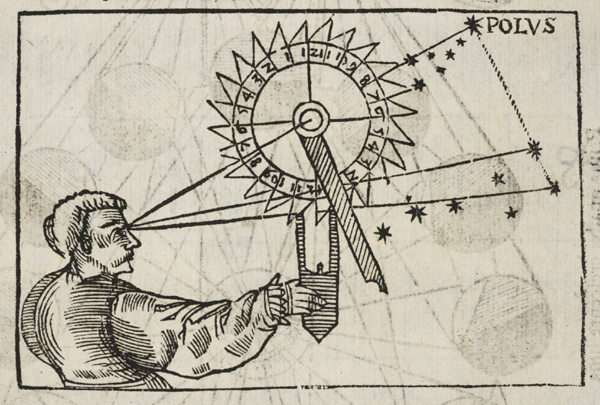
| 5. Telling Time: Nocturnal |
 |
| Peter Apian Instrument Buch (1550) from Lindahall.org |
5. Telling time - Nocturnal: It isn’t nearly easy to tell the time at
night as it is in daylight. One early instrument was a nocturnal, an instrument
used to determine the local time based on the relative positions of two or more
stars in the night sky. The first nocturnals were described in the 12th century.
Internet DIYs for nocturnals aren’t particularly easy to find so two
possibilities can be found at:
•
https://www.instructables.com/id/2d-Nocturnal-Celestial-Stardial-TJT16/
•
https://www.skyandtelescope.com/astronomy-resources/make-a-star-clock/
Make a simple nocturnal and try it out at least three times when you are
observing. Make note of the nocturnal time and clock time. How well does it
work?
Below is a version of a Powerpoint presentation which I made at the May 2019 general meeting of the Denver Astronomical Society:
This activity was totally unanticipated and lots of fun. I've spent
many long nights observing under the stars and I was dimly aware that the Big
Dipper rotated around Polaris through the course of the evening. I was
also aware that the Big Dipper changed orientation with the seasons. But
it never occured to me that these phenomena could be used to determine the time.
I always kind of assumed that once the sun went down you were on the hourglass until dawn.
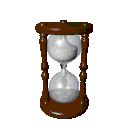
Enter the Nocturnal, nighttime's answer to the sundial.
I favored the Instructables.com version as both the date and time scales were more precise. You can actually set for the exact date. The time scale is graduated to 5 minutes. Also, the star pointer tabs are more precise than trying to match the orientation of the constellation. I feel the design is unnecessarily ornate, but it does have a cutesy steampunk touch. The Sky and Telescope version shown below features a cleaner design and is probably a little more intuitive to use, but not nearly as precise as the Instructables.com version.
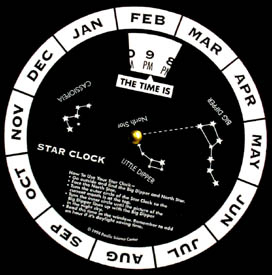
Whichever you choose, this can be a one night project. Cloudy night, of course. Just print the pattern on card stock, laminate, cut out the parts and assemble.
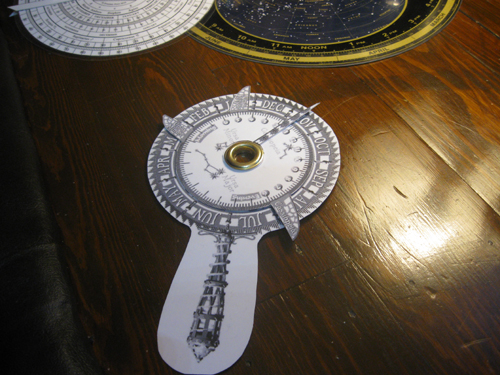
Here's my assembled Instructables "Nocturnal Celestial Stardial" ©2012 Robert Mihaly printed in grayscale. It is available in 3 other color schemes.
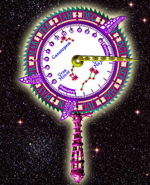 Here's one now. Wow!
Here's one now. Wow!
The stardial is similar in construction to the planisphere and astrolabe in the top of the picture. All three have data plates and pointers that pivot about a central point. Unlike the planisphere and astrolabe, the central pivot of the stardial is actually the hole through which you site the North Star.
The instructions recommend using an eyelet or rivet for the pivot. The eyelet setting tool I had available only had about a two inch throat and would not reach the center of the dial. My son in law came up with a grommet setter used for putting grommets on tarps. Worked like a charm, and left me with a gaping 11.5 mm ocular through which to line up Polaris. The eyelet that holds my planisphere together is only 3.8 mm. With my aging eyes it might be difficult aligning the North Star through the tiny eyelet, but the large grommet proved to be no problem.
Here are my recorded observations and tests of the Nocturnal Celestial Stardial. I tried it at home several times before my trip out to Kline Dark Sky, but my view to the north is pretty washed out lately. Lots of snow on the ground, I think it reflects city light and adds to the skyglow. I'll try more when conditions improve.
| DATE | LOCATION | POINTER STAR FROM CONSTELLATION | SEIKO | ||
| URSA MINOR | URSA MAJOR | CASSIOPEIA | WRISTWATCH | ||
| Feb 1 2019 | EGK Dark Sky | 7:55 PM | 8:00 PM | 8:10 PM | 7:59 PM |
| Feb 24 2019 | Aurora CO | - | 11:15 PM | - | 11:10 PM |
| Jan 14 2020 | EGK Dark Sky | 9:20 PM | 9:20 PM | 9:40 PM | 9:15-9:20 PM |
Pretty spot on for a homemade paper doodad. I
tried it out right away using Stellarium simulations viewed on a 37" flat panel
TV. Uncannily accurate. One caveat: In addition to lining up Polaris
through the center hole, the stardial MUST be held in the vertical/upright position.
Skewing off the vertical will result in inaccurate readings.
If I build an upgraded version (wood, anyone?), I may try to incorporate a
pendulum based leveling system.
An interesting feature of the stardial is that unlike a sundial it is latitude independent. As long as you're far enough north to see the circumpolar constellations you can use the stardial without any adjustment or modification. Adjustment must be made for Daylight Savings time, add 1 hour to reading during DST.
Another correction must be made (as with sundials) to convert star time to civil time. Civil time is defined by the celestial time at the meridian at the center of each time zone. These meridians are in increments of 15o from the prime (Greenwich) meridian. Add or subract 4 minutes for each degree east or west of your time zone meridian. I am fortunate enough to live in Aurora Colorado, in the Mountain Time Zone. The MST meridian is -105o. My longitude is about -104.8o, which would call for adding about 3 minutes to the stardial time, which is a negligible correction.
Another example, Salt Lake City Utah, also in the
Mountain Time Zone at approximately -112o, the stardial would read
nearly half an hour slow. The difference between SLC longitude and the MST
meridian is about 7o.
7o x 4 minutes / o = 28 minutes
The stardial isn't the only way to determine your time by the stars. You could use an astrolabe. If you know the date and can determine true south, you can use the astrolabe to calculate the transit time of any of the stars on the astrolabe rete. Wait for the next bright star to cross the meridian and your astrolabe tells you the time. You can also determine rising and setting times of these stars but they might be harder to use because of horizon viewing conditions.
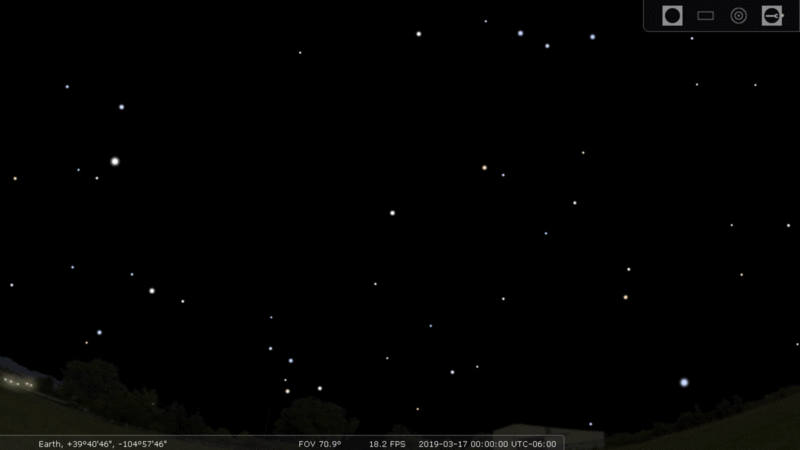
The great celestial clock
--
Astronomy Before the Telescope --
-- Binocrane Home --